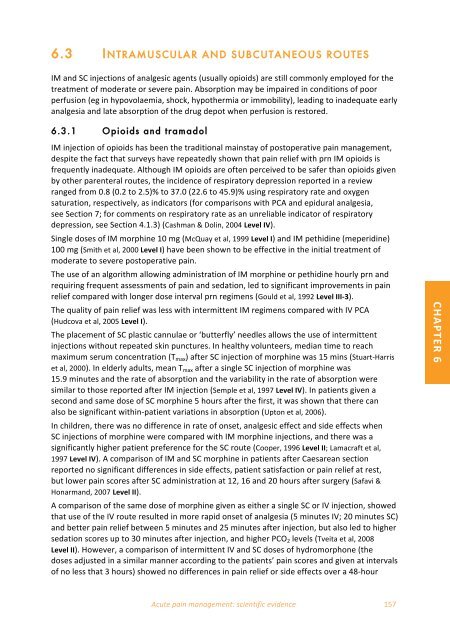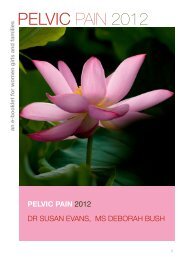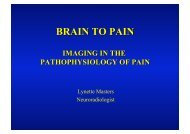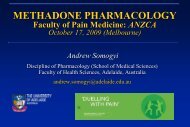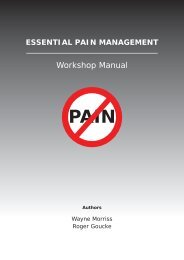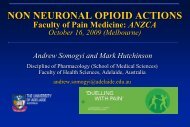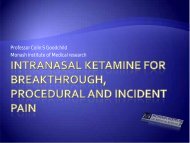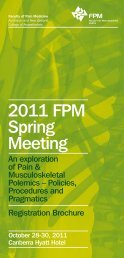Acute Pain - final version - Faculty of pain medicine - Australian and ...
Acute Pain - final version - Faculty of pain medicine - Australian and ...
Acute Pain - final version - Faculty of pain medicine - Australian and ...
Create successful ePaper yourself
Turn your PDF publications into a flip-book with our unique Google optimized e-Paper software.
<br />
<br />
6.3 INTRAMUSCULAR AND SUBCUTANEOUS ROUTES<br />
IM <strong>and</strong> SC injections <strong>of</strong> analgesic agents (usually opioids) are still commonly employed for the <br />
treatment <strong>of</strong> moderate or severe <strong>pain</strong>. Absorption may be impaired in conditions <strong>of</strong> poor <br />
perfusion (eg in hypovolaemia, shock, hypothermia or immobility), leading to inadequate early <br />
analgesia <strong>and</strong> late absorption <strong>of</strong> the drug depot when perfusion is restored. <br />
6.3.1 Opioids <strong>and</strong> tramadol<br />
IM injection <strong>of</strong> opioids has been the traditional mainstay <strong>of</strong> postoperative <strong>pain</strong> management, <br />
despite the fact that surveys have repeatedly shown that <strong>pain</strong> relief with prn IM opioids is <br />
frequently inadequate. Although IM opioids are <strong>of</strong>ten perceived to be safer than opioids given <br />
by other parenteral routes, the incidence <strong>of</strong> respiratory depression reported in a review <br />
ranged from 0.8 (0.2 to 2.5)% to 37.0 (22.6 to 45.9)% using respiratory rate <strong>and</strong> oxygen <br />
saturation, respectively, as indicators (for comparisons with PCA <strong>and</strong> epidural analgesia, <br />
see Section 7; for comments on respiratory rate as an unreliable indicator <strong>of</strong> respiratory <br />
depression, see Section 4.1.3) (Cashman & Dolin, 2004 Level IV). <br />
Single doses <strong>of</strong> IM morphine 10 mg (McQuay et al, 1999 Level I) <strong>and</strong> IM pethidine (meperidine) <br />
100 mg (Smith et al, 2000 Level I) have been shown to be effective in the initial treatment <strong>of</strong> <br />
moderate to severe postoperative <strong>pain</strong>. <br />
The use <strong>of</strong> an algorithm allowing administration <strong>of</strong> IM morphine or pethidine hourly prn <strong>and</strong> <br />
requiring frequent assessments <strong>of</strong> <strong>pain</strong> <strong>and</strong> sedation, led to significant improvements in <strong>pain</strong> <br />
relief compared with longer dose interval prn regimens (Gould et al, 1992 Level III‐3). <br />
The quality <strong>of</strong> <strong>pain</strong> relief was less with intermittent IM regimens compared with IV PCA <br />
(Hudcova et al, 2005 Level I). <br />
The placement <strong>of</strong> SC plastic cannulae or ‘butterfly’ needles allows the use <strong>of</strong> intermittent <br />
injections without repeated skin punctures. In healthy volunteers, median time to reach <br />
maximum serum concentration (T max ) after SC injection <strong>of</strong> morphine was 15 mins (Stuart‐Harris <br />
et al, 2000). In elderly adults, mean T max after a single SC injection <strong>of</strong> morphine was <br />
15.9 minutes <strong>and</strong> the rate <strong>of</strong> absorption <strong>and</strong> the variability in the rate <strong>of</strong> absorption were <br />
similar to those reported after IM injection (Semple et al, 1997 Level IV). In patients given a <br />
second <strong>and</strong> same dose <strong>of</strong> SC morphine 5 hours after the first, it was shown that there can <br />
also be significant within‐patient variations in absorption (Upton et al, 2006). <br />
In children, there was no difference in rate <strong>of</strong> onset, analgesic effect <strong>and</strong> side effects when <br />
SC injections <strong>of</strong> morphine were compared with IM morphine injections, <strong>and</strong> there was a <br />
significantly higher patient preference for the SC route (Cooper, 1996 Level II; Lamacraft et al, <br />
1997 Level IV). A comparison <strong>of</strong> IM <strong>and</strong> SC morphine in patients after Caesarean section <br />
reported no significant differences in side effects, patient satisfaction or <strong>pain</strong> relief at rest, <br />
but lower <strong>pain</strong> scores after SC administration at 12, 16 <strong>and</strong> 20 hours after surgery (Safavi & <br />
Honarm<strong>and</strong>, 2007 Level II). <br />
A comparison <strong>of</strong> the same dose <strong>of</strong> morphine given as either a single SC or IV injection, showed <br />
that use <strong>of</strong> the IV route resulted in more rapid onset <strong>of</strong> analgesia (5 minutes IV; 20 minutes SC) <br />
<strong>and</strong> better <strong>pain</strong> relief between 5 minutes <strong>and</strong> 25 minutes after injection, but also led to higher <br />
sedation scores up to 30 minutes after injection, <strong>and</strong> higher PCO 2 levels (Tveita et al, 2008 <br />
Level II). However, a comparison <strong>of</strong> intermittent IV <strong>and</strong> SC doses <strong>of</strong> hydromorphone (the <br />
doses adjusted in a similar manner according to the patients’ <strong>pain</strong> scores <strong>and</strong> given at intervals <br />
<strong>of</strong> no less that 3 hours) showed no differences in <strong>pain</strong> relief or side effects over a 48‐hour <br />
CHAPTER 6 <br />
<strong>Acute</strong> <strong>pain</strong> management: scientific evidence 157


